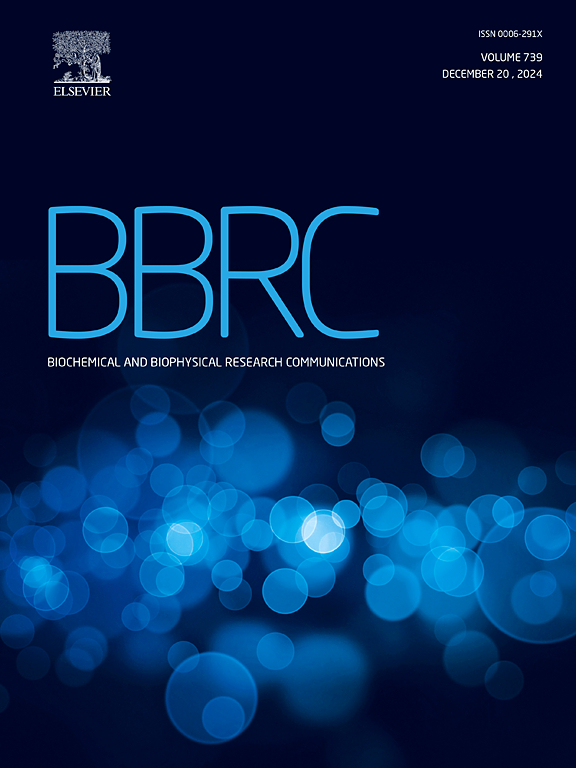含 Gb3 三糖的外泌体是 1 型志贺毒素的新型中和剂。
IF 2.5
3区 生物学
Q3 BIOCHEMISTRY & MOLECULAR BIOLOGY
Biochemical and biophysical research communications
Pub Date : 2024-11-12
DOI:10.1016/j.bbrc.2024.150975
引用次数: 0
摘要
由产志贺毒素大肠杆菌(STEC)和志贺氏痢疾杆菌产生的 1 型(Stx1)和 2 型(Stx2)志贺毒素是导致出血性结肠炎和溶血性尿毒症(HUS)等严重食源性疾病的关键致病因子。Stxs 的受体是 Gb3 和 P1 糖基,它们含有 Galα1→4Gal 表位,由人类 α1,4-半乳糖基转移酶(A4galt)合成。由于抗生素的使用受到限制,治疗方案有限,因此与 Stx 相关的感染对全球公共卫生构成了挑战。因此,迫切需要开发新的治疗策略。本研究提出了一种创新策略,利用从 CHO-Lec2 细胞中提取的外泌体,并用带有 Gb3 碳水化合物表位的功能性垫片-脂质(FSL)共轭物(exo-Gb3-FSL)对其进行修饰。流式细胞仪分析证实,外-Gb3-FSL 构建体上存在 Galα1→4Gal 二糖,使其能够结合 Stx1。此外,利用 CHO-Lec2 细胞评估了外显子-Gb3-FSL 药剂结合 Stx1 并保护这些细胞免受 Stx1 介导的细胞毒性的能力。对于经 Stx1 处理的 CHO-Lec2 细胞,与对照细胞相比,使用 25 μM 的外显子-Gb3-FSL 构建物可提高细胞存活率。这些发现凸显了基于外泌体的抗Stx1药物作为传统疗法替代品的潜力。这种创新策略可能会为 Stx1 中和研究提供新的方向,为治疗 Stx 相关疾病提供有价值的策略。本文章由计算机程序翻译,如有差异,请以英文原文为准。
Gb3 trisaccharide-bearing exosomes as a novel neutralizer for Shiga toxin type 1
Shiga toxin types 1 (Stx1) and 2 (Stx2), produced by Shiga toxin-producing Escherichia coli (STEC) and Shigella dysenteriae, are key virulence factors responsible for severe foodborne diseases, such as hemorrhagic colitis and hemolytic uremic syndrome (HUS). The receptors for Stxs are Gb3 and P1 glycotope, which contain the Galα1→4Gal epitope and are synthesized by human α1,4-galactosyltransferase (A4galt). Stx-related infections pose a global public health challenge, owing to the limited therapeutic options due to the restricted use of antibiotics. Therefore, there is an urgent need to develop novel therapeutic strategies. This study proposes an innovative strategy utilizing exosomes derived from CHO-Lec2 cells, which were modified with Functional-Spacer-Lipid (FSL) conjugates bearing the Gb3 carbohydrate epitope (exo-Gb3-FSL). Flow cytometry analysis confirmed the presence of Galα1→4Gal disaccharides on exo-Gb3-FSL constructs, enabling them to bind Stx1. Moreover, using CHO-Lec2 cells evaluated the ability of exo-Gb3-FSL agents to bind Stx1 and protect these cells from Stx1-mediated cytotoxicity. For Stx1-treated CHO-Lec2 cells, increased cell survival was observed when using 25 μM exo-Gb3-FSL constructs, compared to control cells. These findings highlight the potential of exosome-based anti-Stx1 agents as promising alternatives to conventional therapies. This innovative strategy may provide novel directions for studies on Stx1 neutralization, offering a valuable strategy for the treatment of Stx-related diseases.
求助全文
通过发布文献求助,成功后即可免费获取论文全文。
去求助
来源期刊
CiteScore
6.10
自引率
0.00%
发文量
1400
审稿时长
14 days
期刊介绍:
Biochemical and Biophysical Research Communications is the premier international journal devoted to the very rapid dissemination of timely and significant experimental results in diverse fields of biological research. The development of the "Breakthroughs and Views" section brings the minireview format to the journal, and issues often contain collections of special interest manuscripts. BBRC is published weekly (52 issues/year).Research Areas now include: Biochemistry; biophysics; cell biology; developmental biology; immunology
; molecular biology; neurobiology; plant biology and proteomics

 求助内容:
求助内容: 应助结果提醒方式:
应助结果提醒方式:


